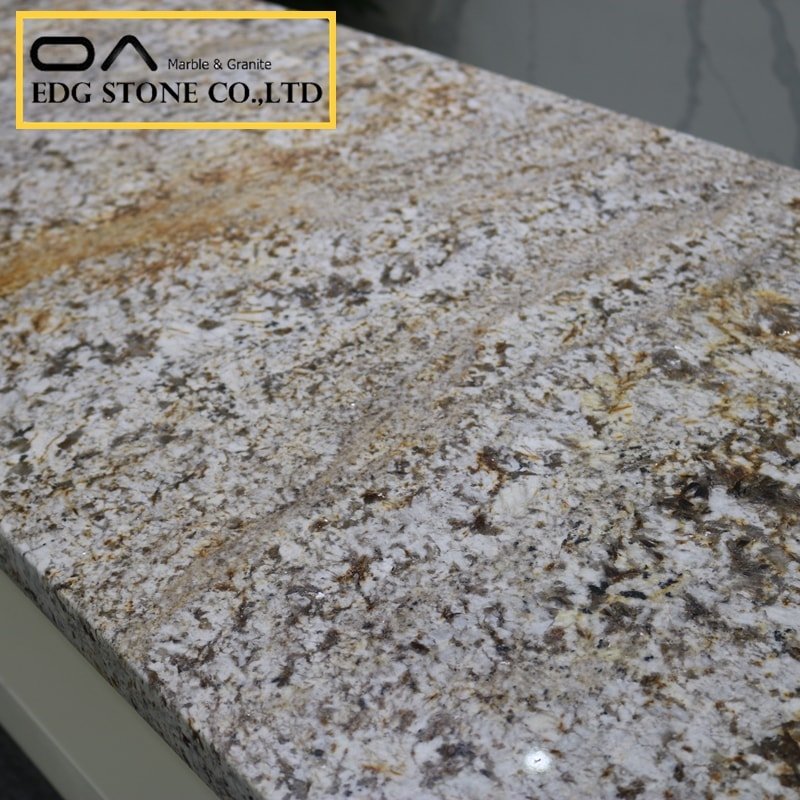Engineered quartz stone countertop
The main component of engineered quartz stone is silica, which is composed of 93% quartz sand as a filler and 7% resin and other binders. Less than 7% has insufficient toughness and is easy to break; higher than 12% is easy to deform. Quartz stone is generally 15 mm thick. The production process of different quartz stone manufacturers can be divided into cast quartz stone and die-cast quartz stone. Quartz stone has a rich variety of colors. In theory, any color can be formulated through various types of pigments.
Quartz stone has excellent scratch resistance and dirt resistance due to its high density and strong hardness. It is not scratched and corrosion-resistant. However, from a physical point of view, quartz stone has fine thermal expansion and contraction properties and has certain mechanical properties such as shrinkage stress, impact toughness, and elongation at break. When the material cannot withstand the internal stress caused by thermal expansion and contraction And cracking occurs when subjected to severe external impact.
The surface of the quartz stone slab is not treated in a special way but is made by more than 30 high-pressure rapid water grinding. Once it is polished at a low speed, it will cause whitening and discoloration. The common problem in the installation joint of quartz stone is that the two plates appear high and low, and the treatment method is often to choose sanding, which will cause the surface of the plate to lose its luster. Therefore, the level of the installation master is tested in the seamless splicing process.
Qualified and high-quality quartz stone adopts a die-casting process, the density can reach 2.46g/cm3, the water absorption rate is 0.02%, and it is better in terms of anti-seepage. However, some unqualified quartz stone products will infiltrate contaminating impurities during daily use and affect their appearance.
What is the difference between die-cast quartz stone and cast quartz stone?
Die-casting quartz stone is produced through a series of equipment such as high temperature, high pressure, and high vibration, because the die-casting plate is stirred with dry powder, formed by vacuum and high pressure, and has high density and hardness. Impermeability, crack resistance, heat resistance, and scratch resistance are all very good.
Casting quartz slabs, in simple terms, is almost the same as ordinary artificial stone. The liquid is solidified on the mold and formed in a vacuum. The equipment cost is low. Generally, artificial stone manufacturers can produce them. The density and hardness are not enough, and it is suitable for penetration. The die-casting plate is mixed with dry powder and the raw material ratio is different. It is formed by vacuum and high pressure, and the density and hardness are higher.
How can we distinguish them quickly?
1. Look, the particles of the cast plate are larger, and the particle distribution is uneven, and the backside is obviously less than the front side. The particles of the die-cast plate are evenly distributed.
2. Use a hard object to scratch, the hardness of the casting plate is lower than 4, and the hardness of the die casting plate is equal to or higher than the Mohs hardness level 6, so the die casting plate will not appear scratches.
3. Comparison of specific gravity, the internal structure of a die-casting plate is compact and stable, with high density. The internal structure of the cast plate is unstable, so the density is low. Therefore, the weight of the die-cast plate is much heavier than the cast plate!
Granite countertops
Granite is the strongest kind of rock, mainly composed of quartz, feldspar, and mica. Its structure? Dense, hard texture, acid and alkali resistance, good weather resistance? It can be used outdoors for a long time. It is not only hard in texture, but also not easily dissolved by water and not easily corroded by acid and alkali. In its area per square centimeter, it can withstand a pressure of more than 2,000 kilograms; in a few decades, weathering cannot have a significant impact on it. The appearance of granite is also quite beautiful, often showing black, white, red, gray, yellow, blue, green, and other colors, with crystals dotted in it, beautiful and generous.
The physical permeability of granite is almost negligible. It is between 0.2% and 4%. It has high strength and heat resistance stability. It will not change due to changes in external temperature. Granite will not change due to its high density. Changes in temperature and air composition. Therefore, it is a good material for a kitchen countertop. Kitchen countertops in European and American countries are usually made of natural granite.
In order to make the color more vivid and even or change the color, some granites are treated with dyeing and electrolysis. This type of granite is not suitable for kitchen countertops.
The thickness of granite countertops is usually 2-3 cm or 3/4-1 inch. 3cm granite countertops are more expensive, but stronger and more attractive. However, 2 cm of granite countertops usually needs plywood support and edge trimming. If you don’t like the standard style, you can ask the manufacturer to design and customize. When you use it with cabinets or other furniture, you need to edge the countertop. Due to the length of granite specifications, splicing is required. Therefore, gaps are very common, and gap sizes within the standard range are allowed.







